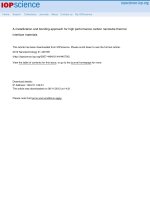carbon nanotube biosensor
Bạn đang xem bản rút gọn của tài liệu. Xem và tải ngay bản đầy đủ của tài liệu tại đây (1.33 MB, 49 trang )
1
Carbon Nanotube Biosensor for
the Assessment of Personal
Quality of Life
Katsuyuki Murata
1
, Masuhiro Abe
2
, Yasuo Ifuku
3
,
Atsuhiko Kojima
4
, Mitsuaki Shimuzu
5
, Masatoshi
Maeda
6
, Tatsuaki Ataka
1
, Kazuhiko Matsumoto
7
1 Olympus Corpration, CREST-JST and NEDO, 2
NEDO, 3 Mitsubishi Kagaku Iatron, 4 Mitsubishi
Chemical, 5 AIST, 6 Tsukuba University, 7 NEDO,
Osaku University, CREST-JST, and AIST
2
Prolegomenon
Quotation from our HP
• Future Creation Laboratory of Olympus
Corporation
– Our goal: enhancement quality of life (QOL)
on mind and body
– The Future Creation Laboratory is committed
to pursuing a variety of research projects
aimed at identifying and creating future values
for enriching people's lives.
3
Our researches
The Future Creation Laboratory conducts highly original
research in "HIKARI"-HI Technology, primarily focusing on four
areas:Bioscience, Humanware, Optics and Nanotechnology and
Ubiquitous energy. Closely linked, these fields will yield new
discoveries and values for the future.
Approaches taken from four research domains
`We explore what future generations
want and what universal values will be like in the future.`
4
Bioscience domain
-Enhance QOL on mind and body-
Our future dreams and goal
In the area of carbon nanotube
(CNT) biosensors research, we are
attempting to establish a
technology that allows the
ultrasensitive measuring (so called
“single molecule detection”) of
biomolecules by applying the CNT
single electron transistor to
biosensors.
This technology will open a new
possibility for home physical check-
ups and will contribute to preventive
medicine and health management
during recovery.
5
Introduction
What is Personal QOL
This project is “Research and
Development of Nanodevices for
Practical Utilization of
Nanotechnology”in NEDO
6
Challenge to nanotechnology of
Olympus
1980
1990
2000
Reinforcement of core competence
A challenge and development to a frontier
2010
Nano
measurement
Nano medical
device
Many functions
Capsule
Precisely
micro
Micro
machine
capsule endoscope
AFMcantilever
biolever
MEMS scanner
Nanobio
living body imitation sensor
end microscope
7
WebPDF file ;21C US security in the 21st centry
Current Japan is
super aged society
Japan → World
Country of current
aged society: about 10
20 years past:
about 20
We take the fastest problem of aging speed underhand
8
Personal QOL system
~Aims to reduce medical cost and promote healthy
intentions~
market size
10trillion yen
in Japan
200-300
trillion yen
in the world
Preventive
medicine
Diagnosis
Treatment
Postoperative
care
current
future
Personal QOL system
•Feature
•24 hours monitor with a terminal in home
•Biotip, microTAS
at home at hospital at home
9
24 hours monitor in home
server at home
network
72
09
:
10
wearable biosensor
Biotip
capsule type biosensor
PQOL system
Central server
Medical care and welfare service institution
10
抗体
カーボンナノチューブ
ソース
ドレイン
抗体
カーボンナノチューブ
ソース
ドレイン
CNT
Source
Drain
Target molecule
CNT-FET
Bioaffinity imaging
MicroTAS
中央サーバ
Cupcel
diagnosis tip
Network
DNA direct reading
NEW
Biotip
Biosensor array
Enhancement of QOL (at-home distant place medical care)
PQOL system
Claim success for introducing
new measurement system
SPM for Bio
Social value
Economic value
Economic value
72
09
:
10
72
09
:
10
11
• Fundamental studies of CNT-transistor
• PQOL system using CNT-Biosensor
Positioning of this study
CREST-JST project: Olympus, AIST, Mitsubishi
Kagaku Iatron, & Osaka Univ.
NEDO project: Olympus, Osaka Univ. & JAIST
12
• CREST-JST Project
• Mainly fundamental
research
– CNT-field effect
transistor (FET)
– using CNT-FET in
biosensor
• NEDO Project
• Investigation for
practical use
– measure yield, ,
quantifiability,
selectivity, sensitivity,
stability, reliability
Establishment of micro
total analysis system
(TAS) by MEMS
technology
Relationship between JST & NEDO
Project
13
Position of CNT biosensors in CNT
applications
Hydrogen storage
Catalyst
Electrode of Fuel cell
Capacitor
Filed emission
DDS
FET
STM tip
Mass-production
method of CNTs must
be established
CNTs not required in large quantities
14
Contents of this presentation
• What is CNT biosensor?
• Problems for practical use and solutions
15
What is CNT-biosensor?
• We studied
– Amperometry
• High reliability
– Potensiometry
• High Sensitivity
16
抗体
カーボンナノチューブ
ソース
ドレイン
CNT
抗体
Potensiometry
antibody
Target molecules
CNT
Source
Drain
CNT
antibody
Amperometry
(Large surface area electrode)
(FET)
CNT biosensor of
Amperometry or Potensiometry
17
Probe
PNA
Target DNA
DNA Hybridization
DNA Hybridization
CNT
V
A
Au
Si substrate
SiO
2
We achieved detection of 6.8 fmol/L of DNA using a CNT-FET
biosensor
Previous CNT-FET biosensor research
18
microTAS
Biosensor array
マルチプレクサー
マルチプレクサー
多項目アレイ
抗体
カーボンナノチューブ
ソース
ドレイン
抗体
Potentiometry
atnibody
Target molecule
CNT
Source
Drain
CNT
antibody
Amperometry
pretreatment
specimen injection
19
Why did we select a CNT
biosensor for PQOL system?
• PQOL system requires
– wearable biosensor
• small and light
•microTAS
– real time sensing
– non disposable
20
CNT biosensor compared with
conventional protein sensing methods
yesnoyessensor array
nono
yesNot
disporsable?
nono
yesReal time
sensing
noyes
yesMobility
most high sensitivitynmol/l order
c.a. 1μmol/l
conventional study
Sensitivity
Chemical luminescence
Chromatography
CNT Biosensor
21
Problems for practical use of CNT-
FET based biosensor
• CREST-JST
– Fundamental design
– Stability & reliability
•NEDO
– Quantifiability
– Sensitivity
– Yield
– Selectivity
22
Contamination provides less
stability of CNT-FET
Washing CNT using aprotic
solvent
23
What is DMSO & DMAC
• aprotic solvent
– Dimethylsulfoxide(DMSO)
– Dimethyl acetamide(DMAC)
O
S
Me Me
O
Me C N
Me Me
24
Aprotic solvent features
• hydrophobic
• hydrophilic
– strong dipole moment
– strong nucleophilicity(basic)
25
Experiments and sample
preparation
Au/Ti Electrode
• Photolithography
•CVD
• EtOH 750sccm
•H2500sccm
• @900℃ 10min.
• Wash by DMAC
CVD process contaminates the CNT with pitch,
amorphous carbons and so on
Photolithography process makes lots of photoresist
residue.









